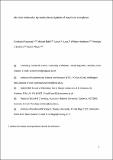Ab initio molecular dynamics investigation of beryllium complexes
Abstract
Structures of aqueous [Be(H2O)4]2+, its outer-sphere and inner-sphere complexes with F-, Cl- and SO42-, as well as dinuclear complexes with a [Be(κ-OH)(κ-SO4)]+ core have been studied through Car-Parrinello molecular dynamics (CPMD) simulations with the BLYP functional. According to constrained CPMD/BLYP simulations and pointwise thermodynamic integration, the free energy of deprotonation of [Be(H2O)4]2+ and its binding free energy with F- are 9.6 kcal mol-1 and -6.2 kcal mol-1, respectively, in good accord with available experimental data. The computed activation barriers for replacing a water ligand in [Be(H2O)4]2+ with F- and SO42-, 10.9 kcal mol-1 and 13.6 kcal mol-1, respectively, are also in good qualitative agreement with available experimental data. These ligand substitution reactions are indicated to follow associative interchange mechanisms with backside (SN2-like) attack of the anion relative to the aquo ligand it is displacing. Outperforming static DFT computations of the salient kinetic and thermodynamic quantities involving simple polarizable continuum solvent models, CPMD simulations are validated as a promising tool to study structures and speciation of beryllium complexes in aqueous solution.
Citation
Raymond , O , Buehl , M , Lane , J , Henderson , W , Brothers , P & Plieger , P 2020 , ' Ab initio molecular dynamics investigation of beryllium complexes ' , Inorganic Chemistry , vol. Articles ASAP . https://doi.org/10.1021/acs.inorgchem.9b03309
Publication
Inorganic Chemistry
Status
Peer reviewed
ISSN
0020-1669Type
Journal article
Description
Authors thank EaStCHEM and the School of Chemistry in St Andrews for support. OR thanks the Marsden Fund of the New Zealand Government (contract MAU1204), administered by the Royal Society of New Zealand for financial support of this work.Collections
Items in the St Andrews Research Repository are protected by copyright, with all rights reserved, unless otherwise indicated.

